Solution Manual for Soils and Foundations 8th Edition Liu
Evett 0135113903 9780135113905
Full link download
Solution Manual:
https://testbankpack.com/p/solution-manual-for-soils-andfoundations-8th-edition-liu-evett-0135113903-9780135113905/ Gradation curve is given on page 2 (2-2)
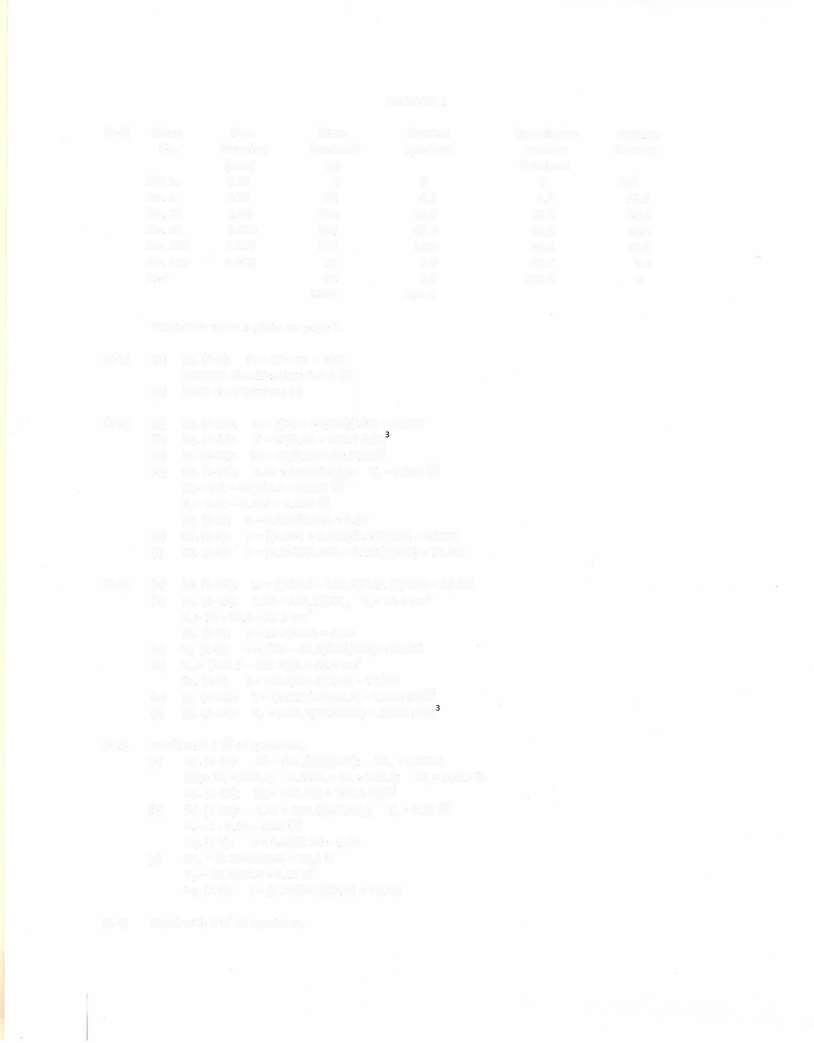
(2-5) Work with 1 ft of specimen (a)
(2-6) Work with 1 ft' of specimen.
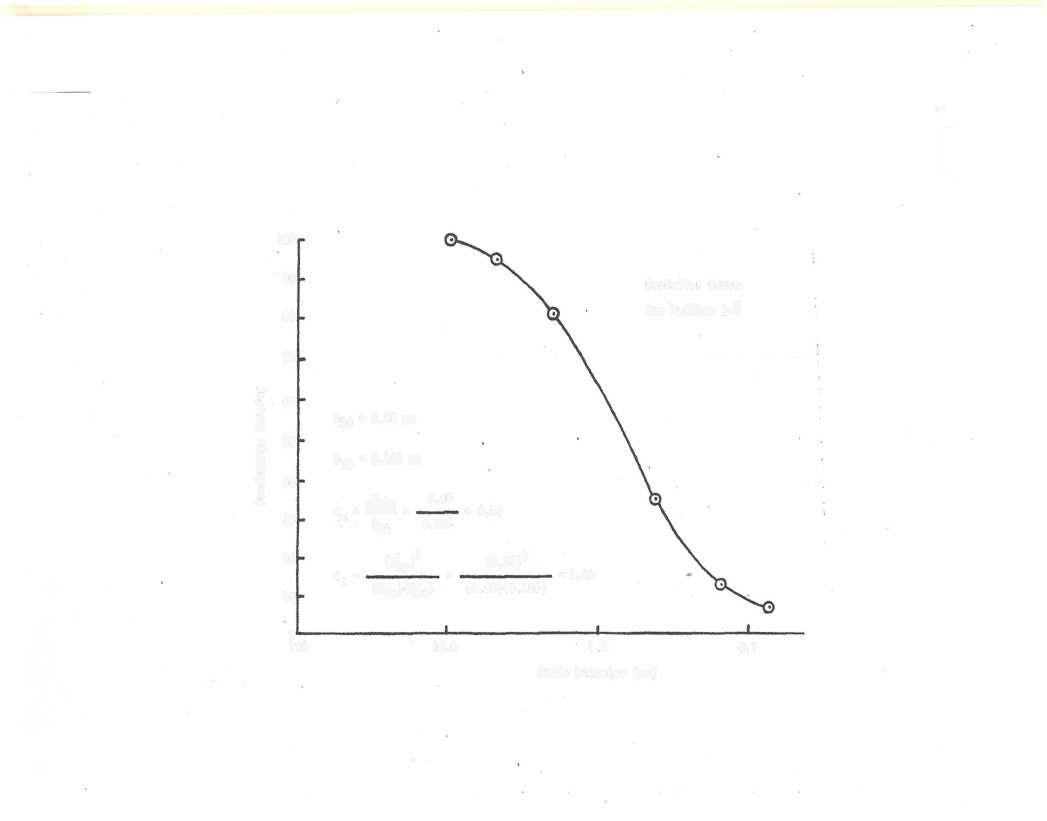
(a) Eq (2-7): 0 56=V/V; V,=0 56V, V,+V,=1; 0 56V,+V,=1; V,=0 64 ft
Eq (2-15): 2 64 = W,/[(0 64)(62 4)]; W, = 105 4 lb
Eq. (2-10): 15 =(W,/105.4)(100); W,= 15.8 lb
W=15 8 + 105 4 = 121 2 lb
E0.(2-11): 'Y=121.2/1=121.2 lb/
(b) E0 (2-12): Y,= 105 4/1 = 105 4 1b/ft
(c) V,=1-0.64=0.36 ft
Eq. (2-8): n =(0.36/1)(100) = 36.0%
(d) Va=15 8/62 4=0 253 ft
Eq (2-9): S=(0 253/0 36)(100) = 70 3%
(2-7) Work with 1 ft' of specimen.
(a) E. (2-10): 42 = (W/W,)(100); W,= 0.42W, W+ W,=112 8; 0 42W,+ W,= 112 8; W,=79 4 lb
W=112.8-79.4= 33.4 lb
V,=33 4/62 4 =0 54 f
V, =1-0 54=0 46 ft
Eq (2-7): e = 0 54/0 46 = 1 17
(Because S = 100%, V= Va )
(b) Eq (2-15): G, = 79 4/[(0 46)(62 4)] = 2 77
(2-8) Work with 1 ft' of specimen
(a) Ea (2-10): 26 = (W/15 80)(100); W,= 4 11 kN
V,=4 11/9 81 =0 419 m°
V,= 1-0 419 =0 581 m?
1% = (4 11 +15 80)/1 = 19 91 k/m?
(b) Eq (2-7): e = 0 419/0 581 = 0 72
(Because S = 100%,V= V% )
(c) Eq (2-15): G,= 15 80/[(0 581)(9 81)] = 2 77
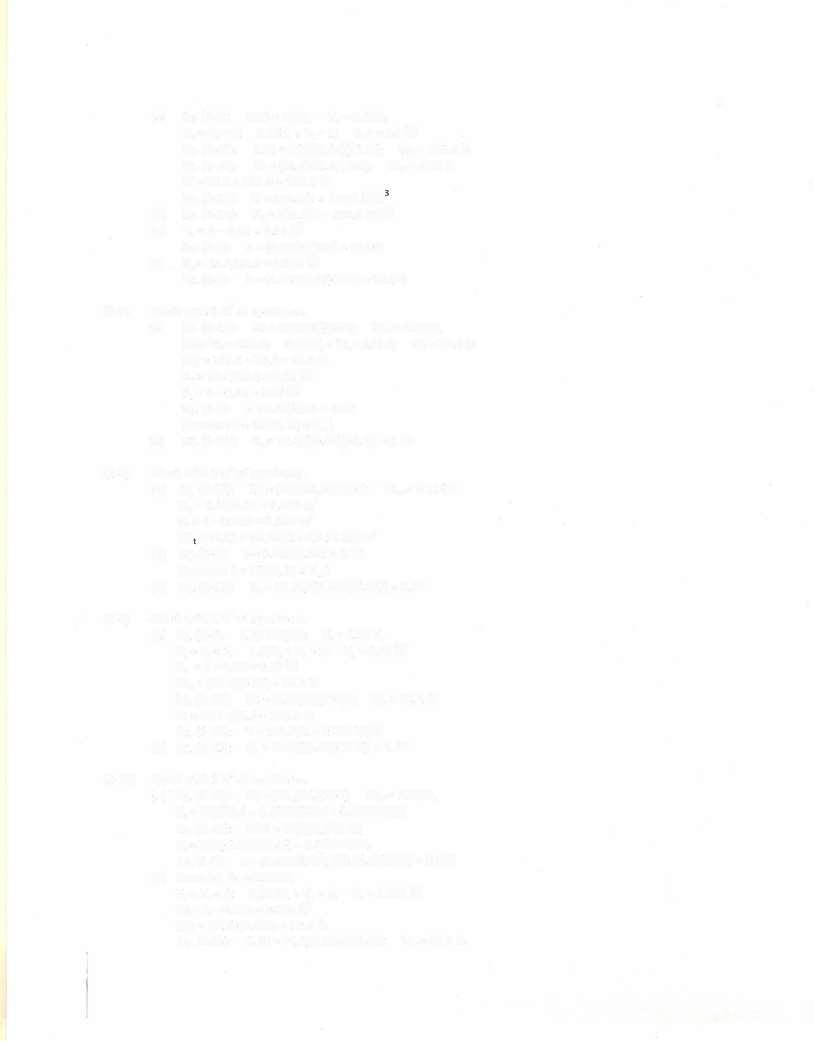
(2-9) Work with 1 ft' of specimen
(a) E0. (2-7): 1.33=/V; V,=1.33 V, V +V,=1; 1 33V,+V,=1; V,=0 43 ft
V, =1-0.43=0.57 f
W,=(62.4)(0.57) = 35.6 lb
Eq (2-10): 48 =(35 6/W)(100); W, = 74 2 1b
W=74 2 +35 6 = 109 8 lb
Eq (2-11): Y= 109 8/1 = 109 8 Ib/ft
(b) Eq. (2-15): G, = 74.2/[(0.43)(62.4)] = 2.77
(2-10) Work with 1 ft' of specimen
(a) Eq (2-10): 35 = (Wa/W,)(100); W,=0 35W, V,,= W/62 4 = 0 35W /62 4 = 0 005609W.
Ea. (2-15): 2.70 = W/[(V,)(62.4)]
V, = W /[(2 70)(62 4)] = 0 005935W,
Eq. (2-7): e =(0.005609W,)/(0.005935W) = 0.945
(b) From (a), V,, = 0.945V, V,+V,=1; 0 945V,+V,=1; V,=0 514 f
V=1-0 514=0 486 ft
Wa=(62 4)(0 486) = 30 3 lb
Ea (2-15): 2 70 = W /[(0 514)(62 4)]; W, = 86 6 lb
W = 86 6 + 30 3 = 116 9 lb
Eq (2-11): 'Y= 116 9/1=116 9 lb/ft
(2-11) Work with 1ft of specimen
(a) Eq (2-7): 0 85 =V/V; V,=0 85V, V,+V,=1; 0.85V,+V,=1; V,=0.54 ft
V=1-0 54=0 46ft
Eq (2-9): 42 =(V%/0 46)(100); V,=0 193 +°
W,=(62 4)(0 193) = 12 04 lb
Eq (2-15): 2 74 = W/[(0 54)(62 4)]; W, = 92 33 lb
E (2-10): w = (12 04/92 33)(100) = 13 04%
W=92.33 +12.04 = 104.37 Ib/ft
(b) Eq (2-11): 'Y= 104 37/1 = 104 4 1b/ft
(2-12) (a) W,=1 445 - 1301 = 0 144 kN Eq (2-10): w =(0 144/1301)(100) = 11 1%
(b) Ea (2-15): 2 65 = 1 301/[(V)(9 81)]; V, = 0 050 m° V,, =0.082 -0.050 = 0.032 m°
Eq (2-7): e = 0 032/0 050 = 0 64
(c) Eq (2-8): n =(0 032/0 082)(100) = 39 0%
(d) V,=(1 445 - 1301)/9 81 =0 015 m
Eq (2-9): S = (0 015/0 032)(100) = 46 9%
(e) Eq (2-11): Y = 1 445/0 082 = 17 62 kN/m'
(f) Eq (2-12): 1= 1 301/0 082 = 15 87 kN/m
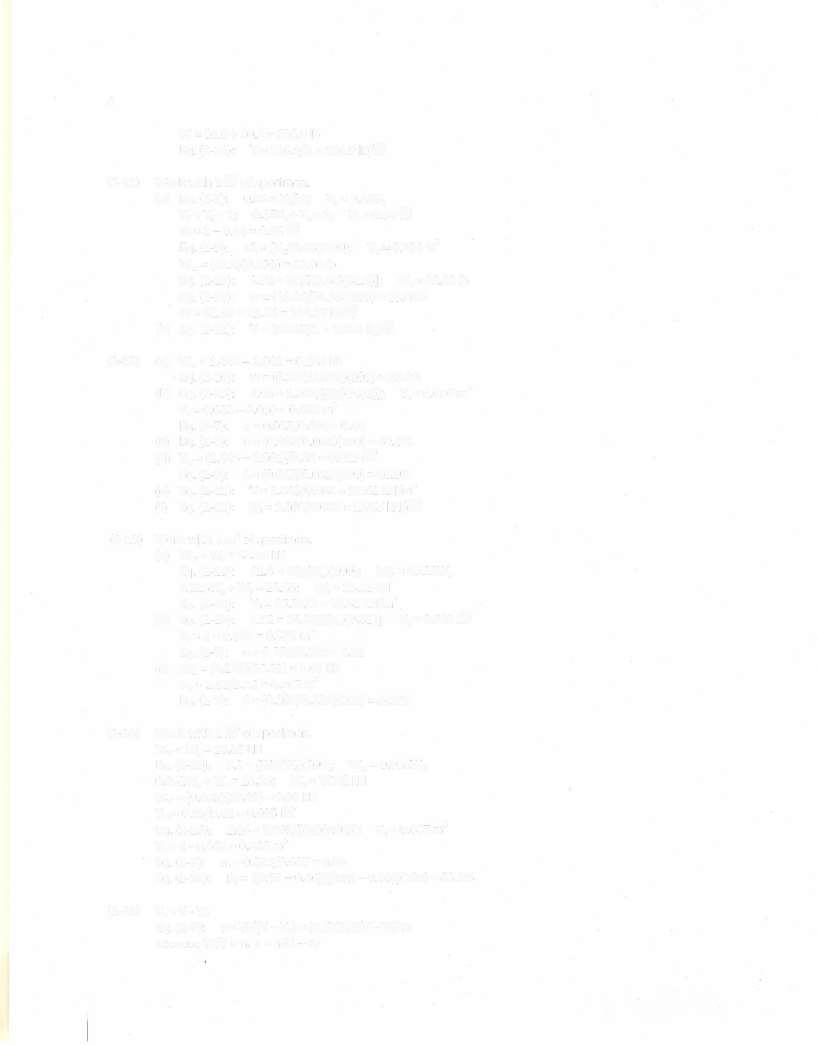
(2-13) Work with 1 m' of specimen
(a) W,+W,= 18 55 kN
Eq (2-10): 12 3 = W/W )(100); W=0 123W, 0 123W + W,= 18 55; W = 16 52 kN
Eq. (2-12): Y,= 16.52/1=16.52 kN/m°
(b) Eq (2-15): 2 72 = 16 52/[(V,)(9 81)]; V,=0 619 m
V,=1-0 619 =0 381 m'
Eq (2-7): e = 0 381/0 619 = 0 62
(c) W,=(0 123)(16 52) = 2 03 kN Va= 2.03/9.81 =0.207 m'
Eq (2-9): S = (0 207/0 381)(100) = 54 3%
(2-14) Work with 1 m of specimen
Wa +W,=18.85 kN
Eq (2-10): 5 2 =(W/W,)(100); W, =0 052W, 0 052W, + W, = 18 85; W,= 17 92 kN
W,=(0 052)(17 92) = 0 93 kN
V,, =0.93/9.81 = 0.095 m
E (2-15): 2.66 = 17.92/[(V)(9.91)] V, = 0.687 m'
V,=1-0 687 =0 313 m?
Eq (2-7): e,=0 313/0 687 = 0 46
Eq (2-18): D, = [(0 92 -0 46)/(0 92 -0 38))(100) = 85 2%
(2-15) V,=V-V
Eq (2-7): e=V/(V-V,)=(V,/V)/(V/V-V/V)
Because V/V = n, e =n/(1-n)
(2-16): V=V, + V,
E. (2-8): n=V/(V+V )=(V/V,)/(V/V, + V/V,)
Because V,/V, = e, n = e/(e + 1)
(2-17) Work with 1ft of specimen
(a) Ea (2-8): 38 = (V/V)(100)
V, = 0 38V= (0 38)(1) =0 38 ft'
V,=1-V,=1-0 38 =0 62 f
Eq (2-7): e = 0 38/0 62 = 0 61
(b) W, =(0 62)(2 66)(62 4) = 1029 lb
Eq (2-9): 35 =(V/0 38)(100); V= 0 133 +°
W,=(0 133)(62 4) = 8 30 lb
W= 8.30 + 102.9 = 111.2 lb
Ea (2-11): 'Y=111 2/1=111 2 lb/+
(2-18) Let subscript "b" denote soil in borrow pit and subscript "d" denote soil in the dam
Eq (2-7): 1 12=(V)/(V)»; (V,)=1 12(V );
(V)+(V,)=Vs; 1.12(V,) +(V.)=V%,
(V, is the total volume of soil from the borrow pit )
(V,)= 0 4717V%
E0 (2-7): 0 78 =(V)/(V ); (V)= 0 78(V,)
(V)+ (V )= 5,000,000
0 78(V,) +(V,)= 5,000,000; (V,)= 2,808,989 m
Because (V,), = (V,), 0 4717V, = 2,808,989
V, = 5,955,000 m'
(2-19) Work with 1ft' of specimen
W +W,= 128 2 lb
Eq. (2-10): 14.5 =(W/W,)(100); W,=0.145W,
0.145W, + W,= 128.2; W,= 112.0lb
W,=128 2 -112 0 = 16 2 lb (initially)
Drying reduces the weight of water by 128.2 - 118.8, or 9.4 lb. Hence, the weight of water after drying is
16 2 -9 4, or 6 8 lb
Eq (2-10): w%% =(6 8/112 0)(100) = 6 1%
(2-20) Work with 1 m of specimen
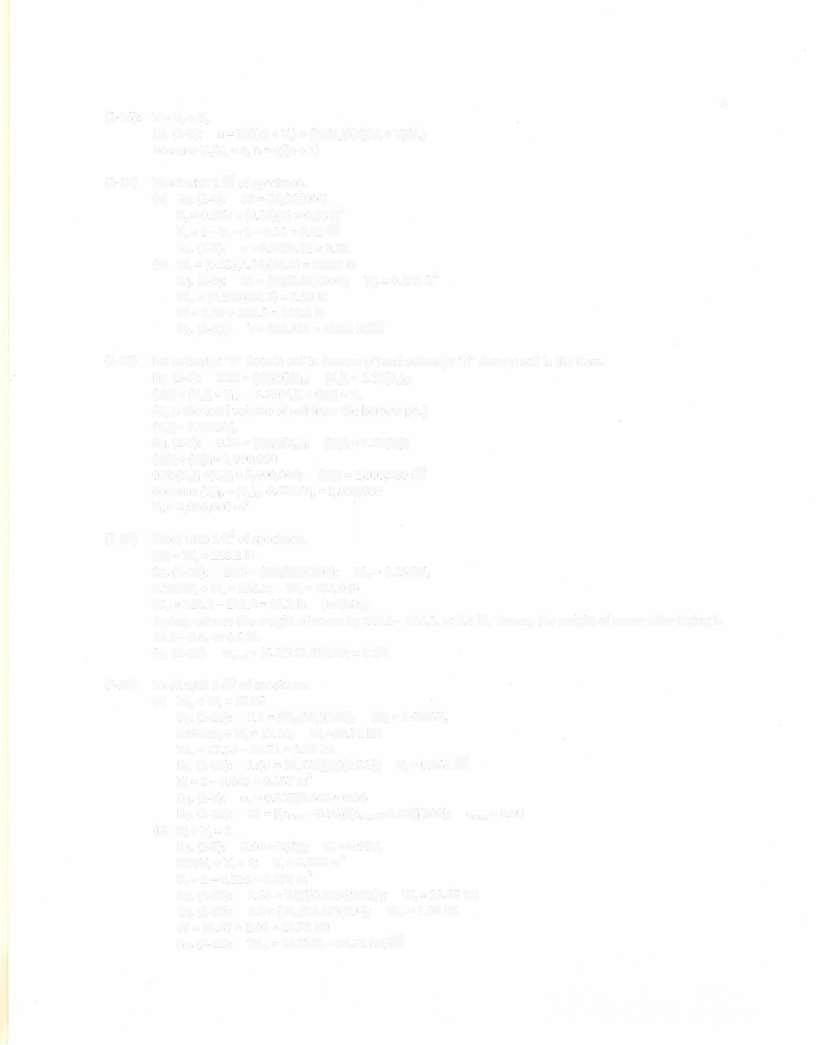
(a) W,+ W,= 17 98
Eq (2-10): 7 6 =(W,/w )(100); W,= 0 076W
0 076W,+ W,= 17 98; W,=16 71 kN
W,= 17 98 - 16 71 = 1 27 kN
E0 (2-15): 2 65 = 16 71/[(V,)(9 81)]; V,=0 643 m
V=1-0 643 =0 357 m°
Eq (2-7): e,=0 357/0 643 = 0 56
Eq (2-18): 62 = [(e%ma -0 56)/(e,%-0 35)](100); em% =0 90
(b) V+V,=1
E0 (2-7): 0 90=V/V; V,=0 90V, 0 90V, +V,=1; V,=0 526 m°
V,=1-0 526 = 0 474 m?
Eq (2-15): 2 65 = W,/[(0 526)(9 81)]; W,= 13 67 kN
Eq. (2-10): 7.6 =(W,/13.67)(100); W,= 1.04 kN
W = 13 67 + 1 04 = 14 71 kN
Eq (2-11): 'Y%%= 14 71/1 = 14 71 kN/m
(2-21) Work with 1 ft' of specimen
V+V,=1
Eq (2-7): 0 85 =V/V; V,=0 85 V, 0.85V,+ V,=1; V,=0.541 ft
V,= 1-0 541 =0 459 f
Eq (2-9): 30 4 =(V,/0 459)(100); V,=0 140f
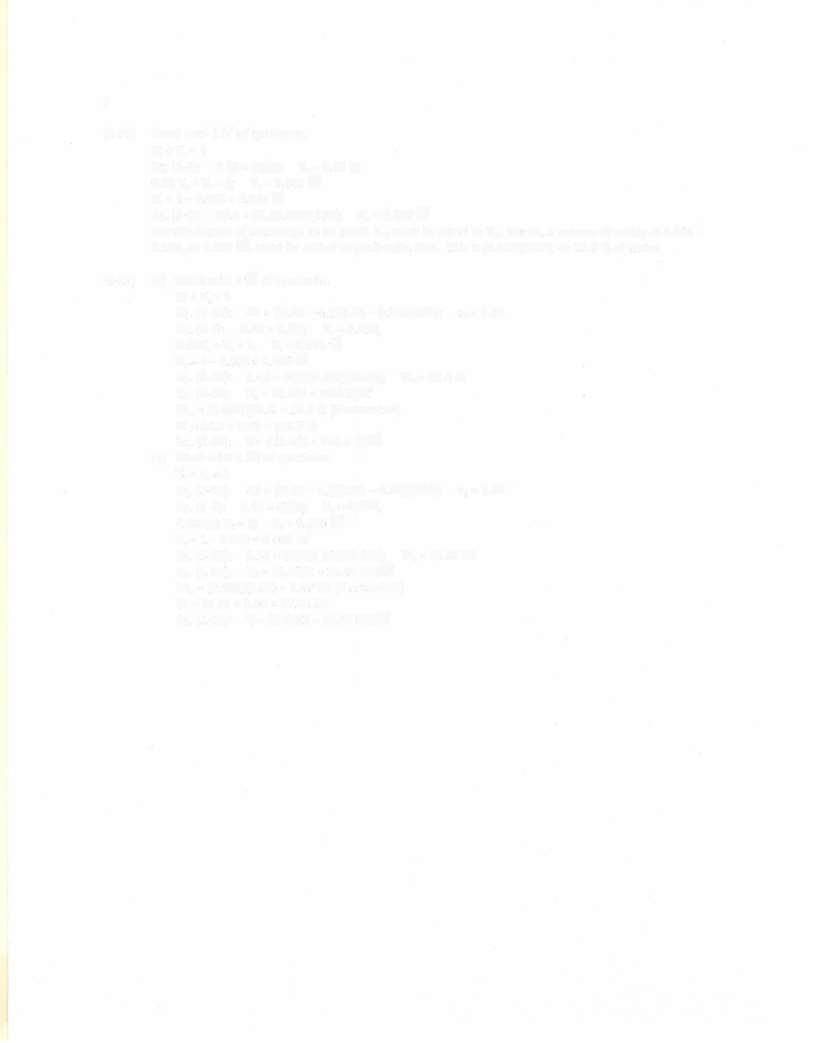
For the degree of saturation to be 100%, V, must be equal to V, Hence, a volume of water of 0.459• 0 140, or 0 319 ft, must be added to each cubic foot This is {0 319)(62 4), or 19 9 lb of water.
(2-22) (a) Work with 1ft of specimen.
V+V,=1
Eq. (2-18): 47 = [(0.95 - e,)/(0.95 --0.38)](100); e, = 0.68
Eq (2-7): 0 68=V,/V; V,,=0 68V, 0 68V, +V,=1; V,=0 595 f
V,,=1-0.595 = 0.405 f
Eq (2-15): 2 65 = W/[(0 595)(62 4)]; W,= 98 4 lb
Eq (2-12): 98 4/1 =98 4 1b/rt°
' , =
W, =(0.405)(62.4) = 25.3 lb (if saturated)
W = 25.3 + 98.4 = 123.7 lb
Eq (2-11): 'Y= 123 7/1 = 123 7 1/+
(b) Work with 1 m of specimen.
V,+V,=1
Eq (2-18): 47 = [(0 95 -e,)/(0 95 -0 38)(100); e, =0 68
Eq (2-7): 0 68=V/V; V,=0 68V, 0 68+V,=1; V,=0 595m
V,=1-0 595 =0 405 m?
E (2-15): 2 65 = W/[(0 595)(9 81)]; W,=15 47 kN
Eq. (2-12): 'Y,=15.47/1=15.47 kN/m
W, =(0.405)(9.81) = 3.97 kN (if saturated)
W=15 47 + 3 97 = 19 44 kN
Ea. (2-11): 'Y= 19.44/1 = 19.44 kN/m
CHAPTER 3
(3-1) (a) p= (10)(120)/2000 = 0.600 ton/ft
Eq (3-1): C=0 77 l0g(20/0 600) = 1 17
Neta =(1 17)(26) = 30
(b) 10 ft = 3 048 m and 120 b/f= 18 85 kN/m?
po =(3 048)(18 85) = 57 45 kN/m'
Eq (3-3): N%area= (26)(100/57 45) = 34
(3-2) (a) p,=[(8)(120) + (2)(120- 62.4)]/2000 = 0.538 ton/f
Eq (3-1): C=0 77l0g(20/0 538) = 1 21
Nrecea =(1 21)(26) = 31
(b) p%= 1.08 kips/ft - 51.71 kN/m
Eq (3-3): Na%recea = (26)(100/51 71) = 36
(3-3) (a) p=(7)(20 40) = 142 8 kN/m
Eq (3-2): C=0 77 l0go (1915/142 8) = 0 868
Nreeea = (0.868)(22)= 19
(b) Eq (3-3): Nreaea = (22)(100/142 8)= 18
(3-4) (a) p=(2)(20.40) +(5)(20.40 -9.81) = 93.75 kN/m'
Ea. (3-2): C,=0 77 l0g, (1915/93 75) = 1 01
Nee« =(1 01)(22)= 22
(b) Eq (3-3): N%cat= (22)(100/93 75)= 23
(3-5) Eq. (3-4): c= 61/{()[(4/12)(8/12)(1/2) + (4/12)(1/6)]) = 449 1b/
=
From Fig. 3-17 with PI = 40%, 0.85. Hence, create = (0.85)(449) = 382 lb/ft
(3-6) A plot of time versus distance is given on page 8.
slopes1 = 0 083/80 = 0 001038
slope%e , = (0 093 -0 08675)/(180 - 100) = 0 00007813 v,
= reciprocal of slope%, = 1/0 001038 = 963 ft/sec
v,=reciprocal of slopen%e 2 = 1/0.00007813 = 12,800 ft/sec
L = 82 ft (from plot on page 8)
Eq (3-6): H, =(82/2)[(12,800 - 963)/(12,800 + 963)] = 38 ft
With v, = 963 ft/sec, according to Table 3-3, the subsurface material in the first layer is estimated to be normal sand or loose sand above the water table With v, = 12,800 ft/sec, according to Table 3-3, the subsurface material in the second layer is estimated to be hard limestone, basalt, granite, or unweathered gneiss
(3-7) Electrode Resistance Resistivity Cumulative
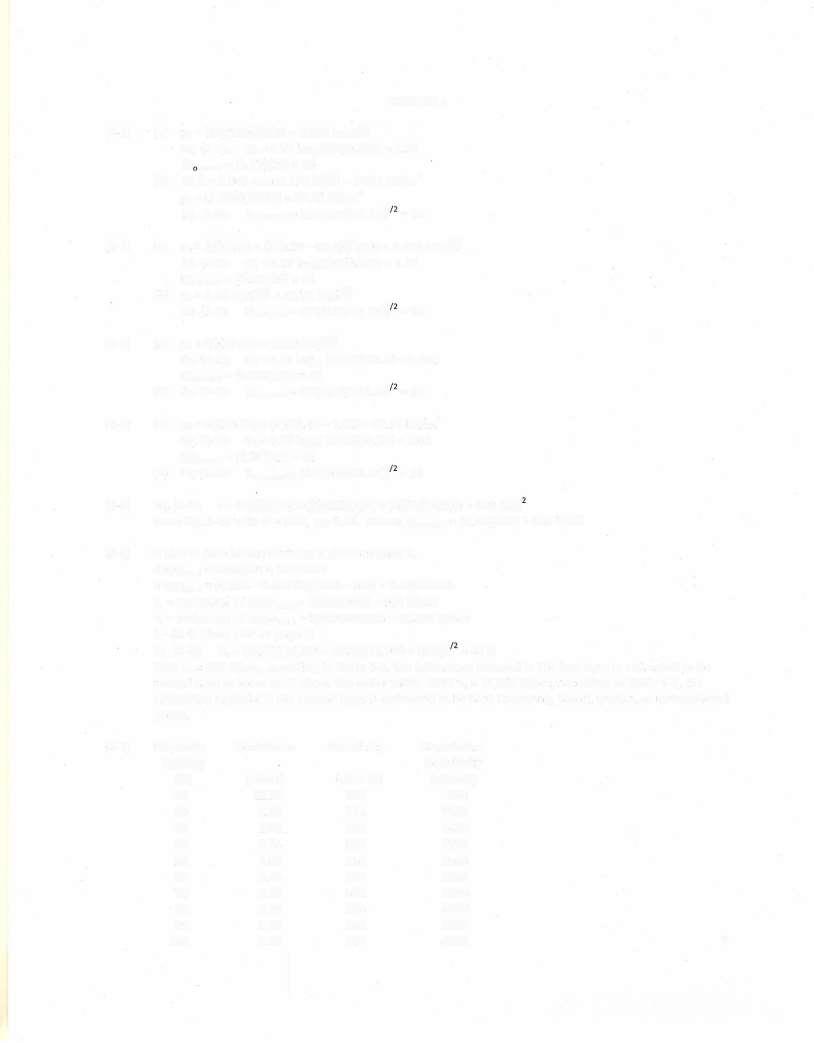
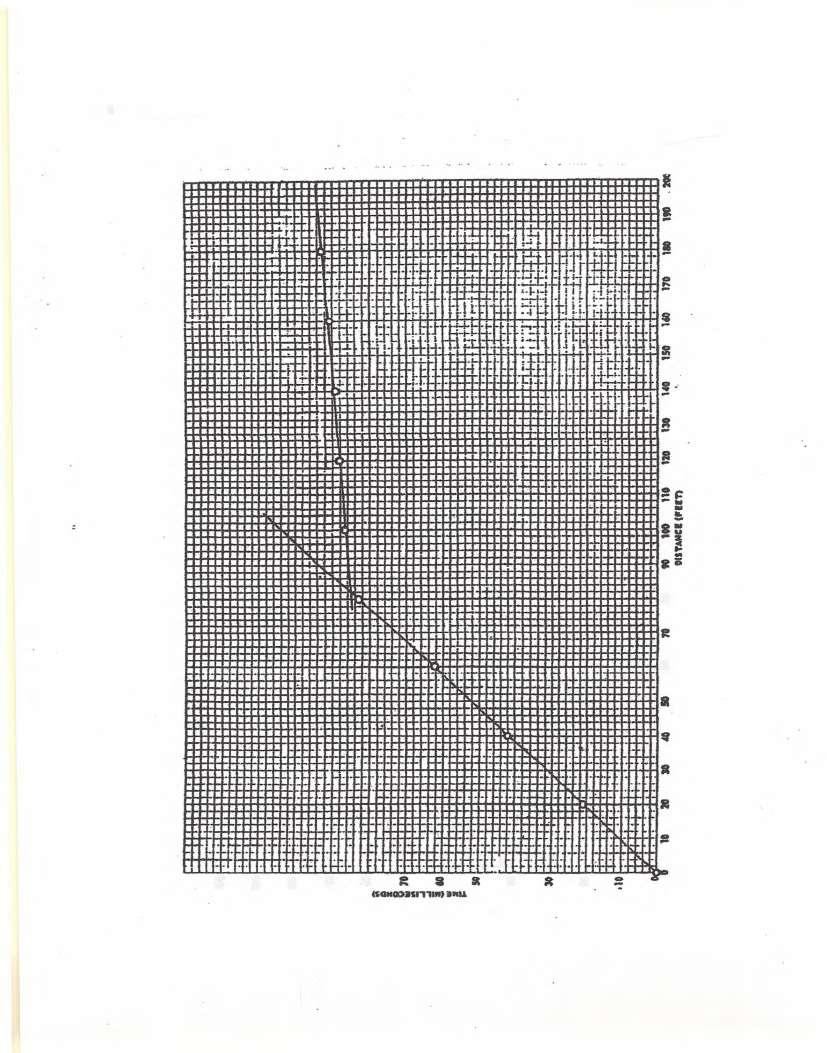
Electrode spacing (column 1 in the preceding table) gives the approximate depth of subsurface material included in a given measurement Resistivity (column 3 in the table) is computed from Eq (3-7), wh ere D is electrode spacing (column 1) and R is resistance (column 2) Hence, for the first row in the table, p=(2)(11)(10)(12 73) = 800 ohm-ft
Values in column 4 are cumulative resistivity values A plot of electrode spacing versus cumulative resistivity is shown on page 10 From this plot, the thickness of the first soil layer is determined to be approximately 63 ft. Because the resistivity of the upper layer is in the range from 50 to 500 ohm-ft, according to Table 3-4, the subsurface material in this layer is estimated to be moist to dry silty and sandy soils Because the resistivity of the lower layer is in the range from 500 to 1000 ohm-ft, according to Table 3-4, the subsurface material in this layer is estimated to be well-fractured to slightly fractured bedrock with moist-soil-filled cracks

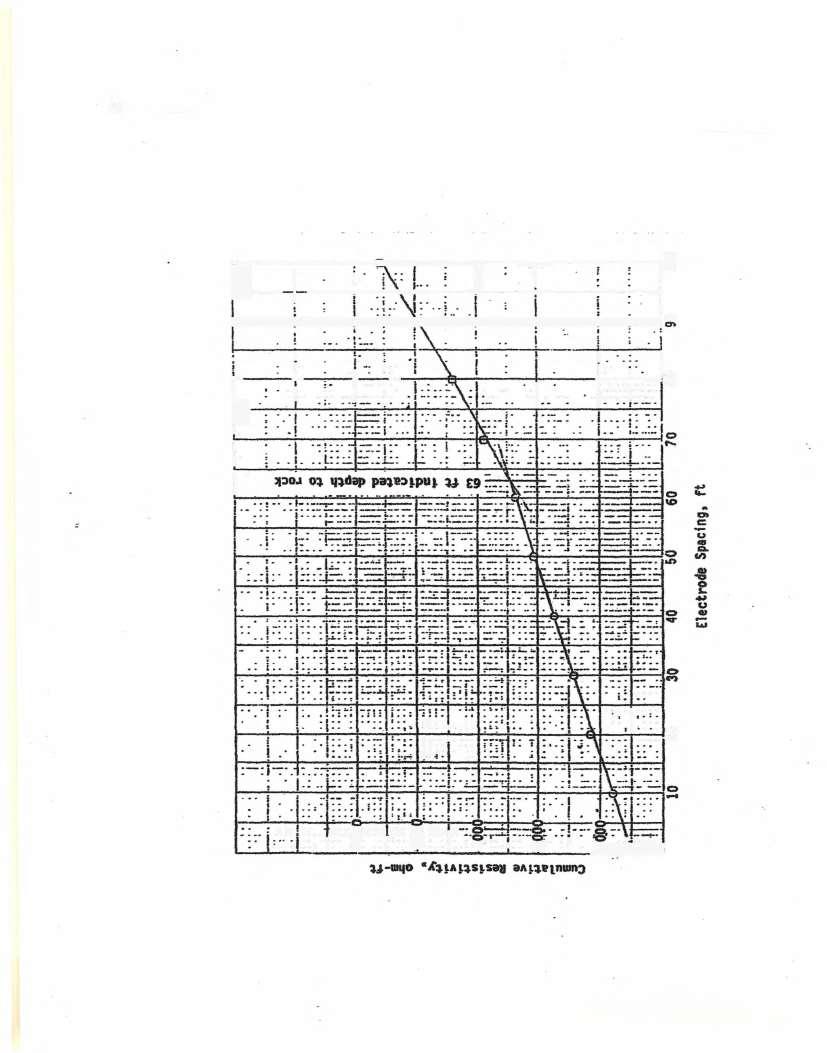
(4-1) Ea (2-11): 'Y= [(3815 -2050)/453.6)/(1/30) = 116.7 lb/ft'
Eq (4-1): Y=116 7/(1+0 091)= 107 0 lb/ft
8 9 10 11 12 13 14 15 16 17 18 19
(4-3) 95% ofthe maximum dry unit weight = (0 95)(112 6) = 107 0 lb/ft
From the compaction curve of Problem 4-2, the range of water content most likely to attain 95% or more ofthe maximum dry unit weight is 9% to 19%
(4-4) From Table 4-3, with maximum dry unit weight = 104.8 lb/ft and optimum moisture content = 20 7%, the possible type of soil for this sample is estimated to be A-7-6 clay or A-6 silty clay
(4-5) Weight of soil used in test hole= 845 -323 = 522 g
Volume oftest hole = (522/453 6)/100 = 0 0115 ft°
Eq.(2-11): 'Y=(648/453.6)/0.0115 = 124.2 Ib/ft'
Eq (4-1): Y=124 2/(1+0 16) = 107 1 lb/f°
(4-6) Percent compaction achieved = (107.1/112.6)(100) =95.1%
(4-7) Let subscript "b" denote soil in borrow pit and subscript "f' denote soil in the fill
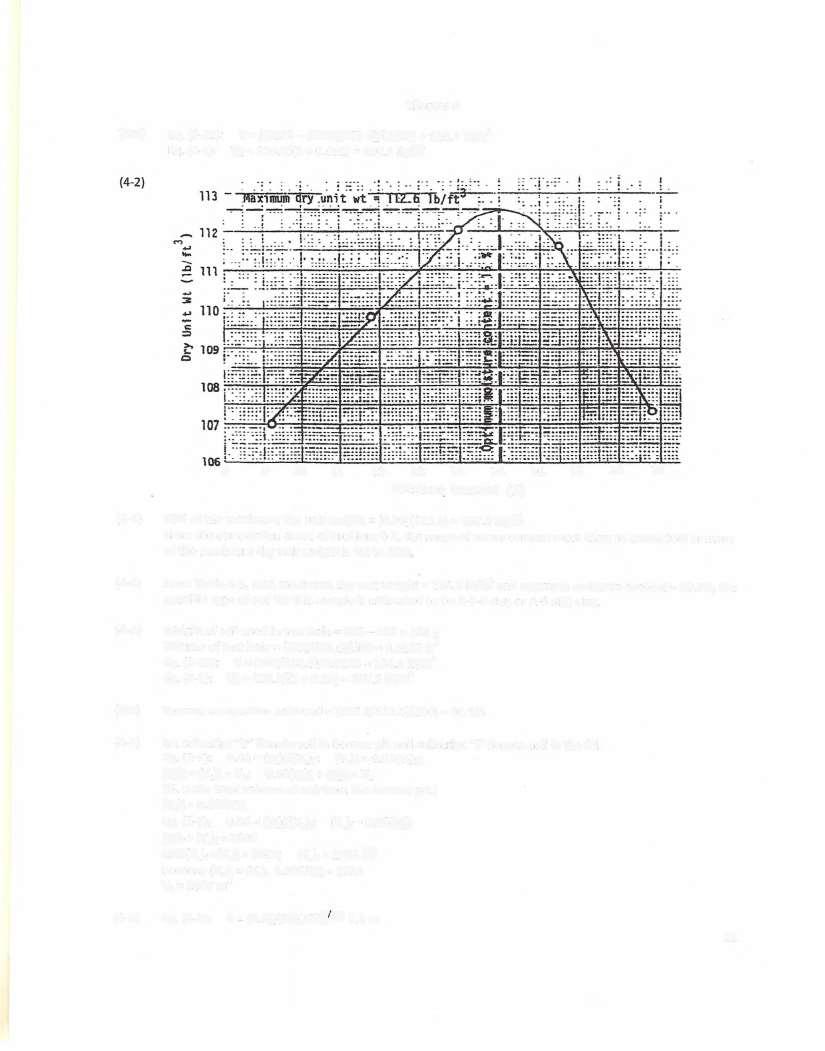
Eq (2-7): 0 68 =(V)/(V ); (V») = 0 68(V2);
(V)+(V.)=V%; 0.68(V) + (V.)=V%
(V, is the total volume of soil from the borrow pit.)
(V,)=0 5952V%
Eq (2-7): 0 45 =(V)/(V )r (V,)r=0 45(V)
(V)r+ (V,)r= 2500
045(V,), +(V,) = 2500; (V,),= 1724 m
Because (V,) = (V,), 0 5952% = 1724
V, = 2897 m?
(4-8) Eq (4-3): D=(0 5)[(20)(10)1=7 1 m
CHAPTER 5
(5-1) k=[(3 60x 10)/2 54](1/12)= 1 18 x 10ft/sec
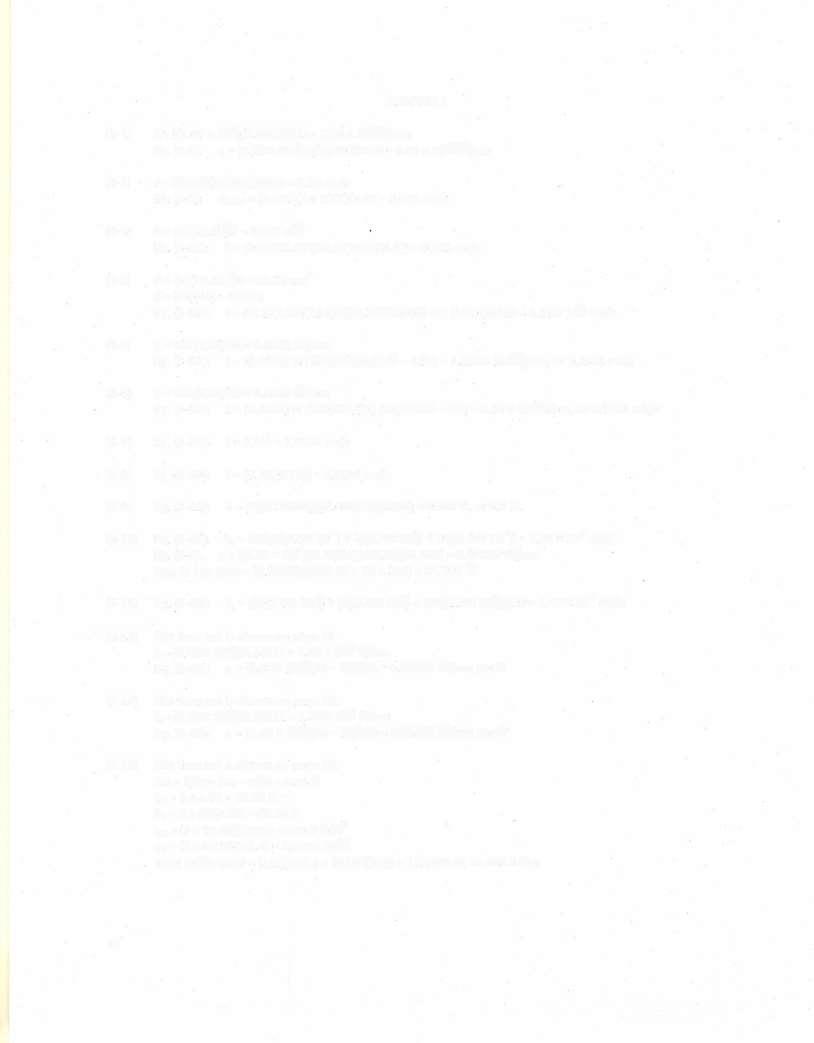
Eq.(5-4): q=(1.1810)(1/5)(400/144) = 6.56 x 10+/sec
(5-2) v= 2000/[(20)(60))/60.0 = 0.28 cm/s
Eq. (5-8): %eta = (0.028)(1 +0.71)/0.71 = 0.067 cm/s
(5-3) A=(rt)(10.0)/4 = 78.54 cm
E (5-11): k = {500){12 0)/[(78 54)(152)(4 9)] = 0 103 cm/s
(5-4) A=(rt)(10 20)/4 = 81 71 cm'
T=(35)(60) = 2100 s
E0 (5-18): k = {(2 3)(1 95)(16 2)/[(81 71)(2100)] log (100 0/920) = 1 53 10 cm/s
(5-5) q =185/7 48/60 =0 4122 ft/sec
Ea (5-28): k=(0 4122) In (100/50)/[(r)(15 12)] = 1 123 10ft/sec, or 0 0342 cm/s
(5-6) q= 205/7 48/60 = 0 4568 ft/sec
Eq (5-23): k=(0 4568) In (150/75)/[(2) (r)(12)(20 - 16)] = 1 05 x 10ft/sec, or 0 0320 cm/s
(5-7) Eq. (5-29): k=0.18 = 0.0324 cm/s
(5-8) Eq (5-30): k =(0 35)(0 25) = 0 0219 cm/s
(5-9) Eq (5-42): h = (4)(0 00504)/[(0
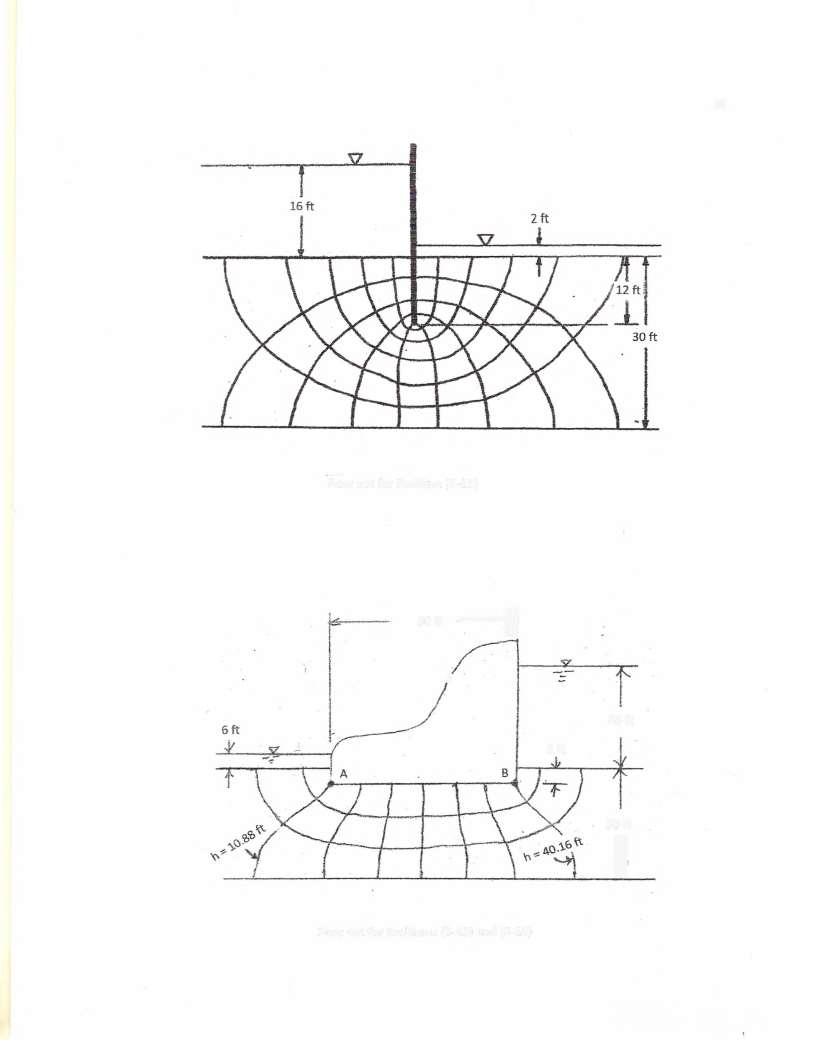
CHAPTER 6
(6-1) Eq (6-2): D=(20 72)(2 5) + (20 72 -9 81)(6) +(19 69 -9 81)(7)= 186 kN/m
p% = 186 + 128 = 314 kN/m
Eq (6-3): Eq (6-4): 1,=(9.81)(6+ 7) = 128 kN/m
(6-2) E (6-7): p=(3)(200,000)/{(2)(r)(15)[1 + (0/15)1) = 424 1b/
(6-3) Ea (6-7): p=(3)(200,000)/{(2)(r)(15)[1 +(10/15)1)-= 169 lb/r
(6-4) P=(5000)(10)(7 5) = 375,000 lb
Eq (6-10): p=375,000/[(10 + 12)(7 5 + 12)] = 874 1b/ft
(6-5) P =(195)(2)(3)= 1170kN
Eq (6-10): (a) Pae1a= 1170/[(2 + 1)(3 +1)] =97 50 kN/m'
(b) paes%a= 1170/[(2 +3)(3 +3)] = 39 00 kN/m : (c) Pats%=1170/[(2+5)(3+5)]= 20 89 kN/m'
(6-6) (a) z/a =18/12 =1 5; r/a = 0/10 = 0; Influence coefficient= 0 424
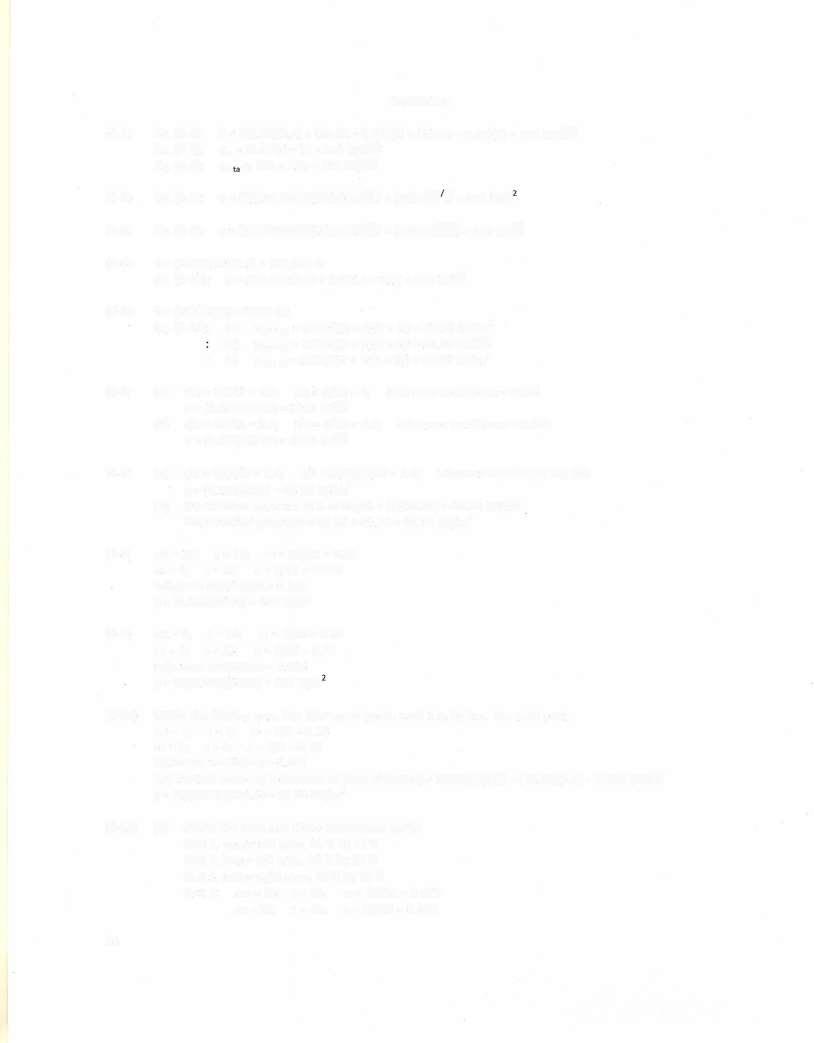
p =(0 424)(4500) = 1908 Ib/ft
(b) z/a = 18/12 = 1 5; r/a = 6/12 = 0 5; Influence coefficient= 0 374
p=(0 374)(4500) = 1683 lb/ft
(6-7) (a) z/a =3/(3/2)=2 0; r/a =(3/2)/(3/2)= 1.0; Influence coefficient= 0 194
p=(0 194)(250) =48 50 kN/m'
(b) Overburden pressure at 3-m depth = (3)(16.38) = 49.14 kN/m
Total vertical pressure= 48 50 + 49.14 = 97.64 kN/m2
(6-8) mz = 12; z=15; m = 12/15 =0.80
nz = 8; z=15; n = 8/15 = 0 533
Influence coefficient = 0 115
p =(0 115)(6000) = 690 1b/f
(6-9) mz = 6; z=25; m =6/25 = 0 24
nz = 6; z=25; n = 6/25 = 0.24
Influence coefficient= 0.026
p=(4)(0 026)(5000) = 520 lb/f
(6-10) Divide the footing area into four equal parts, each 1 m by lm. For each part,
mz=1; z=4; m=1/4=0 25
nz=1; z=4; n = 1/4 =0 25
Influence coefficient = 0.027
Net vertical pressure increment at baseof footing = 1000/[(2)(2)]-(16 80)(1 8) = 219 8 kN/m
p=(4)(0.027)(219.8) = 23.74 kN/m'
(6-11) (a) Divide the area into three rectangular parts:
Part 1, upper left area, 16 ft by 12 ft
Part 2, lower left area, 16 ft by 12 ft
Part 3, lower right area, 20 ft by 12 ft
Part 1: mz = 16; z=24; nz =12; z =24; m = 16/24 = 0.667 n = 12/24 =0 500
Influence coefficient= 0.101
Part 2: mz = 16; z = 24; m = 16/24 = 0 667
nz = 12; z = 24; n = 12/24 =0 500
Influence coefficient= 0 101
Part 3: mz = 20; z =24; m = 20/24= 0 833
nz=12; z=24; n =12/24 =0.500
Influence coefficient =0 112
p =(0.101 +0.101 +0.112)(2000) = 628 Ib/ft
(b) Divide the area into threerectangular parts:
Part 1, left area, 16 ft by 24 ft
Part 2, bottom area, 36 ft by 12 ft
Part 3, lower left area, 16 ft by 12 ft
Part 1: mz = 16; z = 24; m = 16/24 = 0 667
nz = 24; z =24; n = 24/24 = 1 000
Influence coefficient =0 145
Part2: mz= 36; z = 24; m = 36/24 = 1 500
nz= 12; z=24; n = 12/24 = 0 500
Influence coefficient =0.131
Part 3: mz = 16; z=24; m = 16/24 = 0 667
nz = 12; z= 24; n = 12/24 =0 500
Influence coefficient =0 101
p=(0 145 + 0 131-0 101)(2000) = 350 b/f
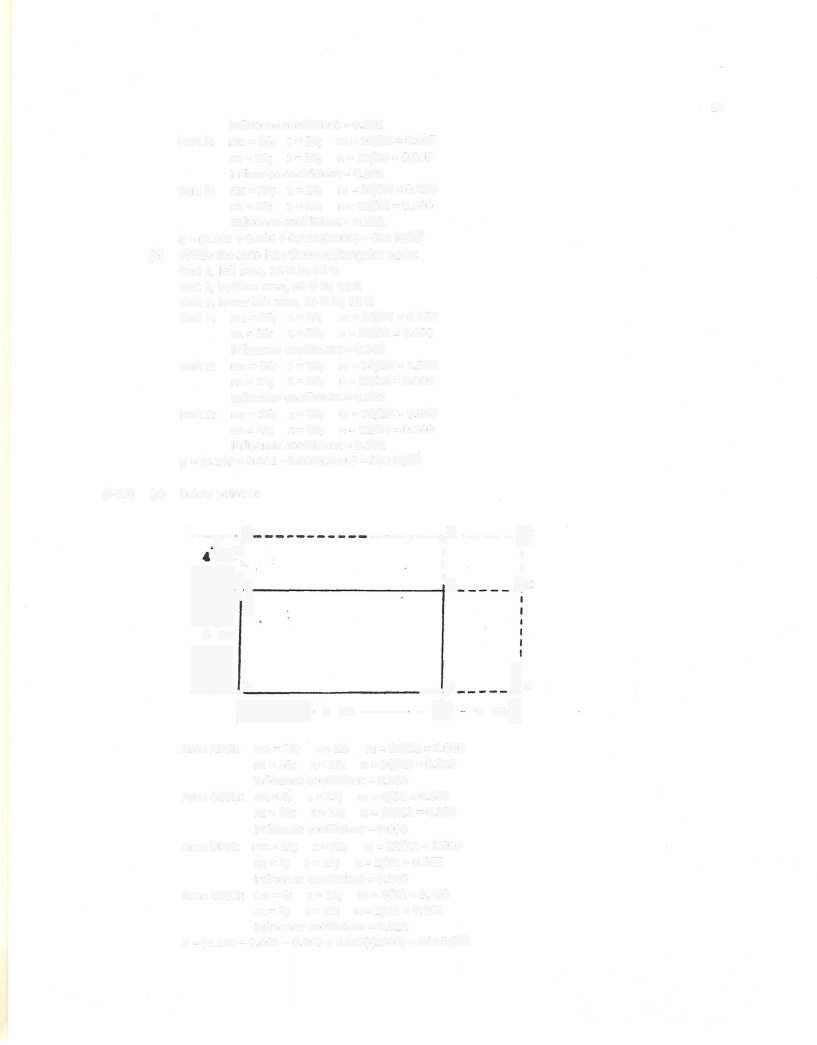
(6-12) (a) Below point G:
z' .
Area BFJG: mz =4; z=12; m = 4/12 =0 333
nz = 6; z=12; n =6/12 = 0.500
Influence coefficient= 0 062
Area GJEA: same asArea BFJC:
Influence coefficient =0 062
Area FCHJ: mz =4; z = 12; m =4/12 =0 333
nz = 2; z=12; n =2/12 = 0.167
Influence coefficient = 0 022
Area JHDE: same as Area FCHJ:
Influence coefficient =0 022
p =(0 062 + 0 062 +0.022 +0 022)(2500) =420 lb/ft
(6-13) Reduction in vertical pressure at base of foundation (i e , 5 m below ground level) = (1860)(5) = 93 0 kN/m.
mz = 58 m; z=15 m; m = 58/15 = 3 87
nz = 38 m; z=15 m; n = 38/15 =2 53
Influence coefficient= 0 243
The reduction at one corner of the building at a depth of 15 m below the original surface = (0.243)(93.0) = 22 6 kN/m
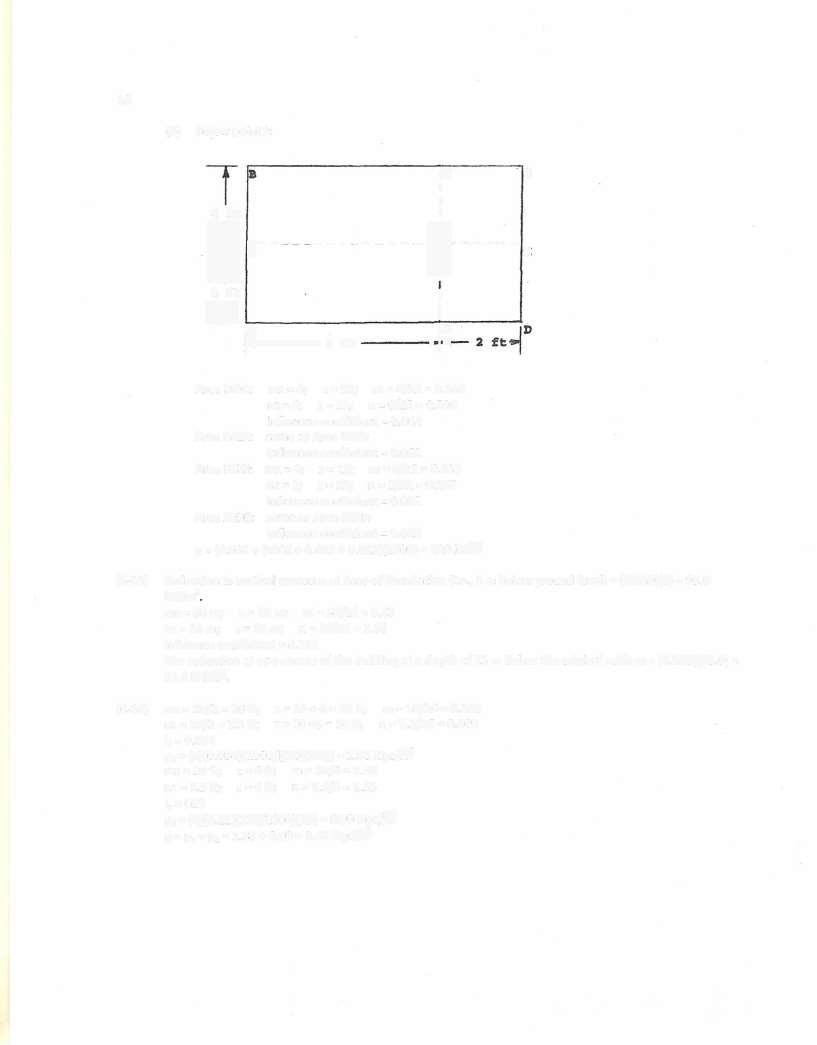
(6-14) mz = 20/2=10ft; z=10+6=16ft; m=10/16 =0 625
nz = 15/2 = 7.5 ft; z = 10+6 = 16 ft; n = 7 5/16 = 0 469
I, =0 094
p, = (4)(0 094){1500/[(20)(15)]} = 1.88 kips/ft
mz = 10 ft; z=6ft; m = 10/6 = 1 67
nz =7.5 ft; z=6 ft; n =7.5/6=1.25
1,=021
p,=(4)(0 21)(118/1000)(10) = 099 kips/ft
p=p,+p,=1 88 +0 99 = 2.87 kips/ft
=
mz = 1 0; z =96 0-(92 6 + 84 2)/2 = 7 6; m = 10/7 6=0 132
nz= 1 0; z=7 6; n = 1 0/7 6 =0 132
Influence coefficient = 0.0085
Ap = (4)(0.0085)(198.84) = 6.76 kN/m'
p=po+Ap=113 38 + 6 76 = 120 14 kN/m'
H = 92 6 - 842 = 8.4 m
Eq (7-19): S,=(0 60)[(8 4)/[1 + 1 058)] log (120 14/113 38) = 0 062 m
(7-6) From Fig 7-17, for 90% primary consolidation, T,, = 0 848
(a) H=(92 6 -84 2)/2 = 4 20 m
Eq. (7-29): t%, =[0.848/(6.98 10)1(4.20) = 2,143,000 min, or 4.08 yr
(b) T, and c, are the same as for (a).
H = 92 6 -84 2 = 8 40 m
Eq (7-29): to, = [0 848/(6 98 10)](8 40) = 8,572,000 min, or 16 3 yr
(7-7) (a) po at midheight of clay layer = (120)(100 - 85) + (103 - 62 4)(85 - 76)/2 = 1983 lb/ft', or 1 0 ton/ft
0 4e, = (0 4)(1 80) = 0 72
The "e-log p" curve is shown on page 18
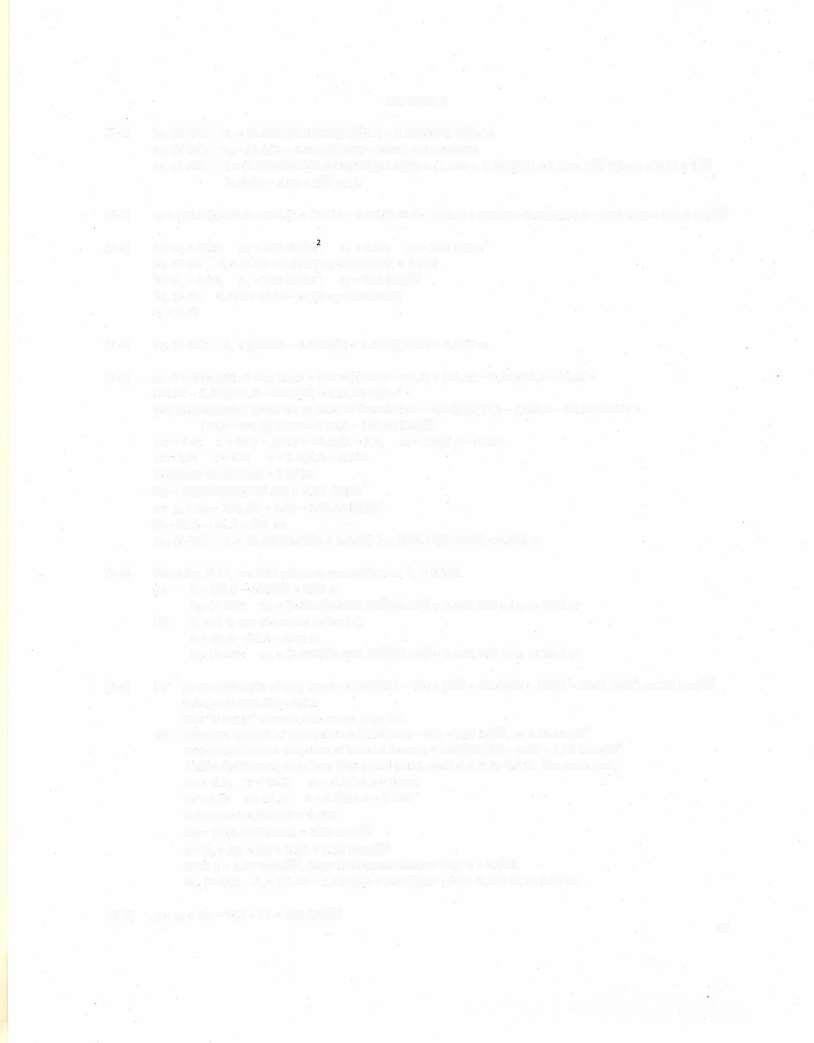
(b) Effective weight of excavation = (120)(100 - 94) = 720 lb/ft', or 0 36 ton/ft'
Net consolidation pressure at base of footing = 200/[(9)(9)] -0 36 = 2 11 tons/ft'
Divide the footing area into four equal parts, each 4 5 ft by 4 5 ft For each part, mz = 4 5; z = 13 5; m = 4 5/13 5 = 0 333
nz=4.5; z=13.5; n = 4.5/13.5=0.333
Influence coefficient= 0 045
Ap = (4)(0 045)(2 11) = 0 38 ton/ft
p=p+Ap=1 0+0 38 = 1 38 tons/ft'
With p = 1 38 tons/ft, from field consolidation line, e = 1 705
Eq. (7-15): S,= [(1.80- 1.705)/(1 + 1.80)](85 -76) = 0.305 ft, or 3.66 in.
(7-8) p=p+Ap=108+52 = 160 kN/m
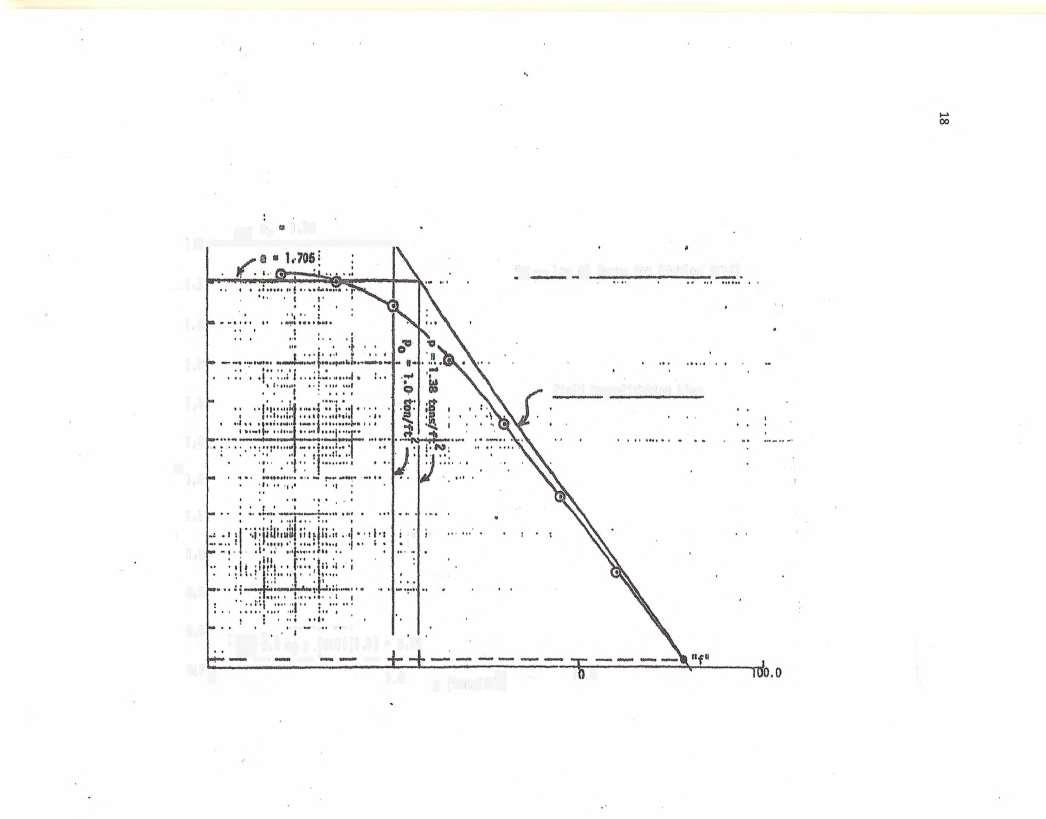
[p = 160kN/m] > [p' = 125 kN/m']; Use Eq. (7-22).
S, =(0 06)[3 8/(1 +0 70)] log (125/108) + (0 30)[3 8/(1 + 0 70)] log (160/125) = 0 080 m, or 80 mm
(7-9) Because the compressible clay layer is underlain by permeable sand and gravel, this is a double drainage for clay layer, with H =(85 - 76)/2 = 4 5 ft
(1) When U = 10%, T, = 0.0077 (from Fig. 7-17).
Eq (7-29): t,%= [0 0077/(2 18 10))(4 5 12) = 10,300 min, or 0 020 yr
(2) When U = 20%, T, = 0 0314
to = [0 0314/(2 18 x 10)](4 5 x 12) = 42,001 min, or 0 080 yr
(3) When U = 30%, T,, = 0 0707
t%% =[0 0707/(2 18 x 10))(4 5 x 12) = 94,569 min, or 0 180 yr
(4) When U = 40%, T,, = 0 126
t,=[0 126/(2 18 10)](4 5 12) = 168,539 min, or 0 321 yr
(5) When U = 50%, T,= 0 196
ta, = [0 196/(2 18 10)](4 5 12) = 262,172 min, or 0 499 yr
(6) When U = 60%, T, = 0.286
t, =[0 286/(2 18 x 10)](4 5 12) = 382,558 min, or 0 728 yr
(7) When U = 70%, T, = 0 403
t,=[0 403/02 18 10))(4 5 12) = 539,059 min, or 1 026 yr
(8) When U = 80%, T, = 0 567
t% = [0 567/(2 18 x 10)](4 5 12) = 758,428 min, or 1 443 yr
(9) When U = 90%, T,, = 0 848
te% =[0 848/(2 18 x 10)(4 5 x 12) = 1,134,297 min, or 2 158 yr
U (fraction of total settlement) Settlement Time
The time-versus-settlement curve is given on page 20

(7-10) p=po+Ap =108 +52 = 160 kN/m' [p = 160 kN/m'] < [p' = 185 kN/m]; Use Eq (7-21)
$, =(0 06)[3 8/(1 + 0 70)] log (160/108) = 0 023 m, or 23 mm
(7-11) (1) When U= 90%, T,= 0 848 (from Fig 7-17)
H=12 ft (single drainage)
Eq (7-29): ts, =[0 848/(9 04 x10)](12 12) = 19,451,469 min, or 37 yr
(2) 1yr= 525,600 min
Eq (7-29): 525,600 = [T/(9 04 10)1(12 12)
T, =0 023
From Fig 7-17, with T, = 0 023, U = 15% Settlement at 1 yr = (0 15)(4 60) = 0 69 in
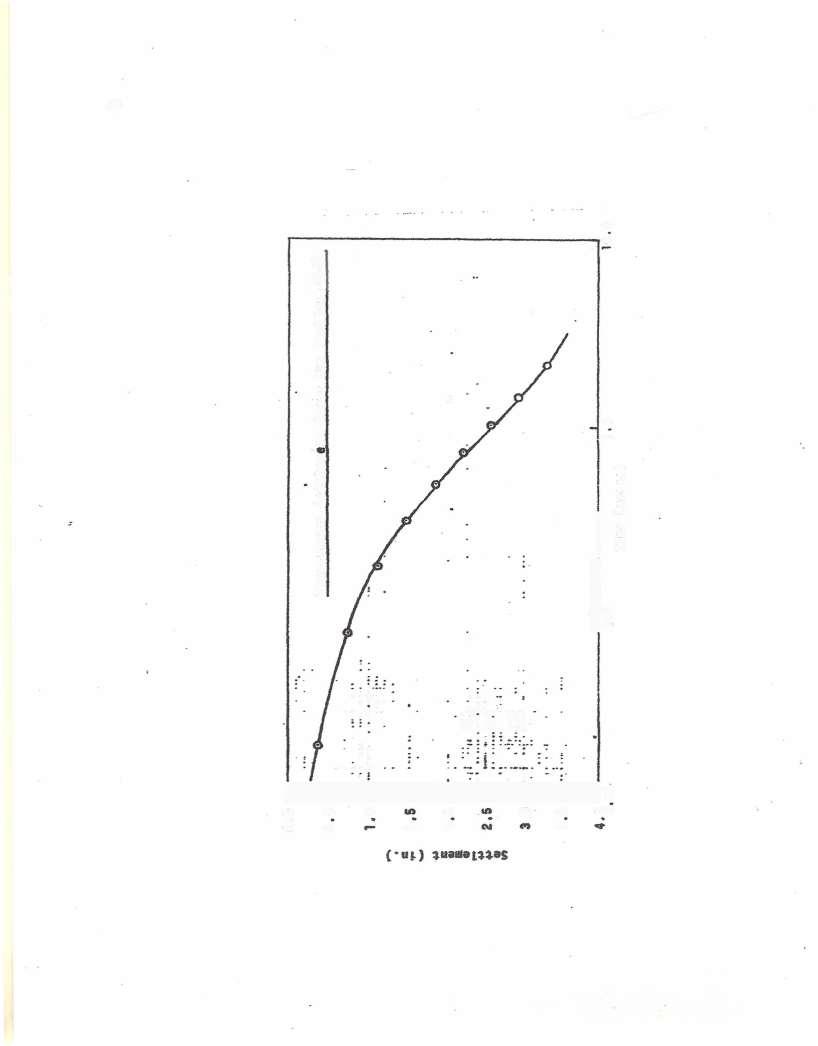
(3) U=(1/4 60)(100) 21 7%
From Fig 7-17, with U = 21 7%, T, = 0 040
Eq (7-29): t=0 040/(9 04 x 10))(12 x 12) = 917,522 min, or 1 75 yr
(7-12) From Fig 7-21, with a natural water content of 35%, C,, =0 007
H=92 6 - 84 2=8 4 m
Eq. (7-30): S, = (0.007)(8.4) log (40/14) = 0.027 m
(7-13) The appropriate depths for calculating the average corrected N-values are 6 ft to 15 ft
For a depth of 5 ft, average corrected N-value = 28
For a depth of 7 5 ft, average corrected N-value = (28 + 27)/2 = 28
For a depth of 10 ft, average corrected N-value =(28 + 27 + 30)/3= 28
For a depth of 12 5 ft, average corrected N-value =(28 + 27 + 30 + 28)/4 = 28
For a depth of 15 ft, average corrected N-value =(28 + 27 + 30 + 28 + 23)/5 = 27
The lowest average corrected N-value is 27
=300/[(9)(9)] = 3 70 tons/ft
E (7-31): S%%= [(2)(370)/271[(2)(9)/(1 + 9)] =0 89 in
(7-14) From Problem 7-13, Sm% =0 89 in on dry sand
pa= (130)(6 +9/2) = 1365 lb/ft'
p,=(8)(130) + (6 +4 5 - 8)(130- 62 4) = 1209 lb/ft
Eq (7-32): x, = 1365/1209 = 1 129
Sm% =(1 129)(0 89) = 1 00 in
(7-15) Eq (7-31): 1=(20/18)[(2)(6)/(1 + 6)]
q =3 06 tons/ft
(7-16) pa= (118)(6 +6/2) = 1062 Ib/ft
P,= (118)(8) +(118 - 62.4)(1) = 1000 1b/+
Eq (7-32): x% = 1062/1000 = 1 062
From Problem 7-15, if no groundwater was encountered, q = 3.06 tons/ft' for 1 in. of settlement. When the groundwater table is at a depth below the base of the footing less than B/2, the s,ms computed should be multiplied by xa. Therefore, in this problem, q = 3.06 tons/ft will produce (1)(1.062) in. of settlement.
Therefore, 3 06/1 062 = allowable for 1-in. settlement/1
aiowable for 1-in settlement= 2 88 tons/ft
(7-17) For Eq (7-33),
po=(17 5)(1)= 17 5 kN/m
Ap = 800/[(2)(2)] -(17 5)(1)= 182 5 kN/m
€,=1-(0 5)(17 5/182 5) =0 952
C,=1+0 2l0g [(10)(4)]=1 32
The value of the summation term in Eq (7-33) is 10 5 x 10 m'/kN (determined from the graph and the table on page 22)
Eq (7-33): S=(0 952)(132)(182 5)(10 5 10) = 0 024 m, or 24 mm
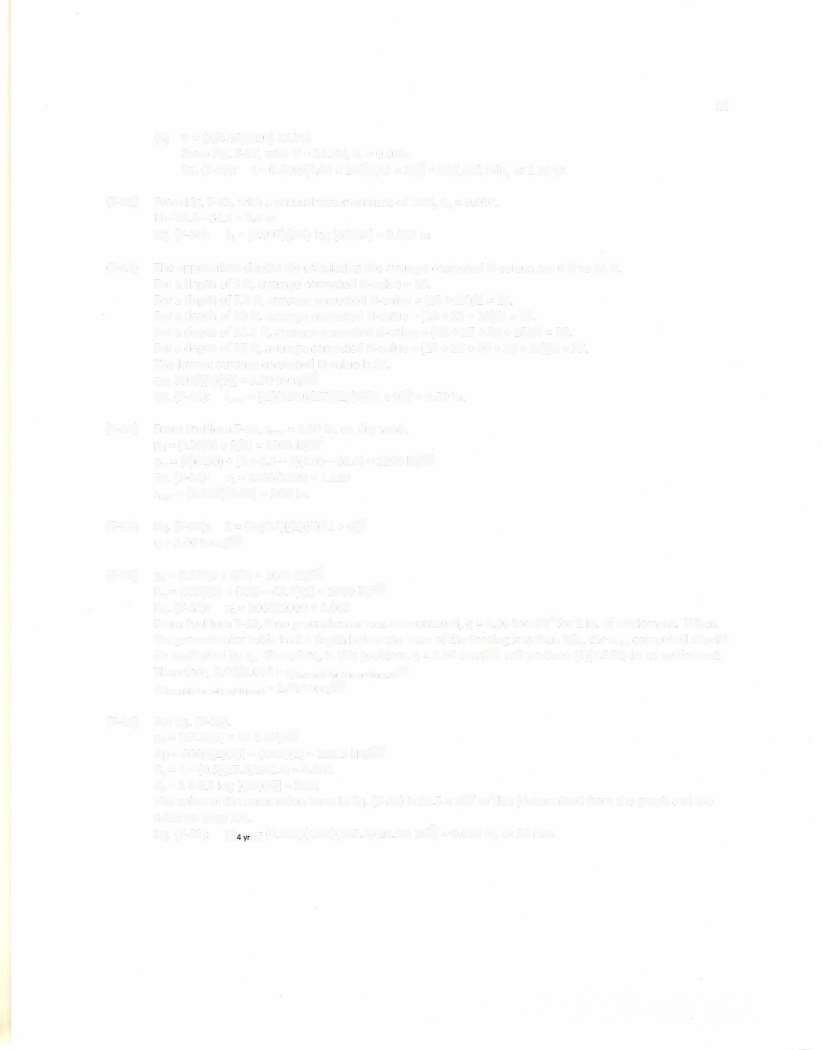
*Column headings are:
A Layerthickness (A2z), m
B Depth from base of footing to center of layer, m
C Modulus of elasticity of sand layer (E,), kN/m'
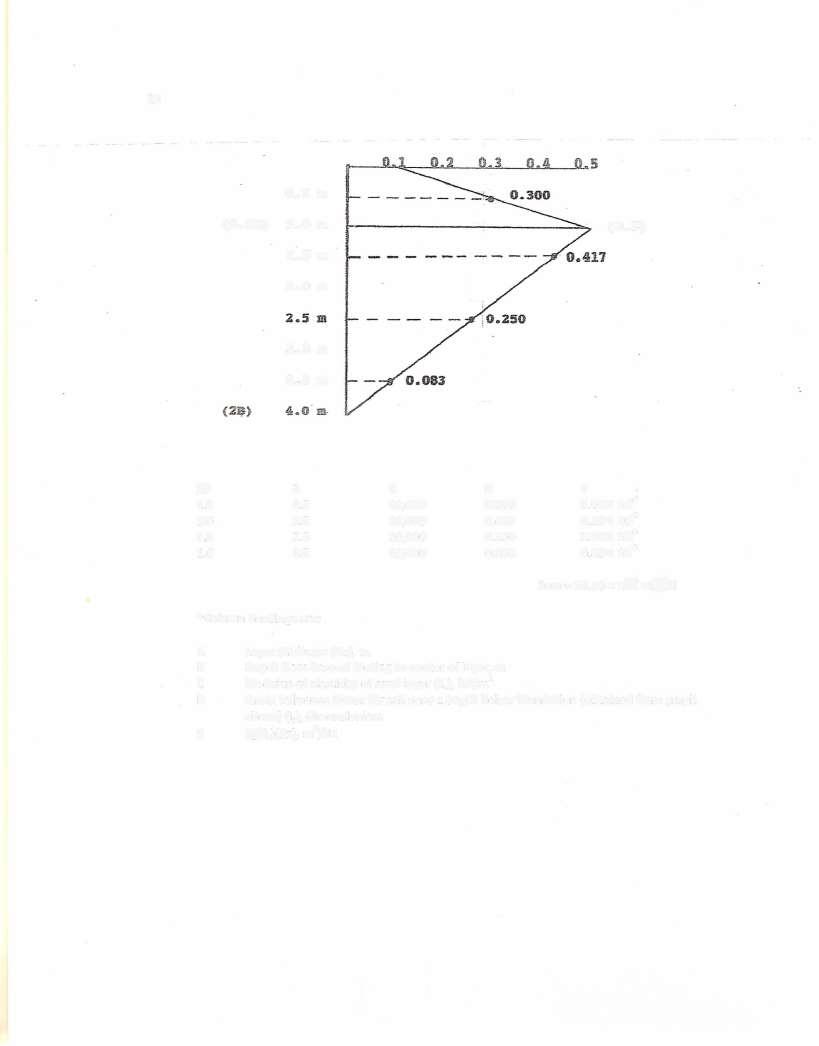
D Strain influence factor for soil zone z depth below foundation (obtained from graph above) (I,), dimensionless
E (/E,)(4z), m'/kN
